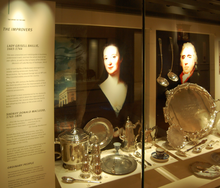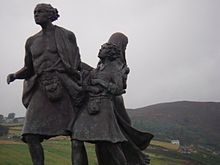- Highland Clearances
-
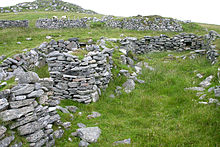 Ruined croft houses on Fuaigh Mòr in Loch Roag. The island was cleared of its inhabitants in 1841 and is now only used for grazing sheep.
Ruined croft houses on Fuaigh Mòr in Loch Roag. The island was cleared of its inhabitants in 1841 and is now only used for grazing sheep.
The Highland Clearances (Scottish Gaelic: Fuadach nan Gàidheal, the expulsion of the Gael) were forced displacements of the population of the Scottish Highlands during the 18th and 19th centuries. They led to mass emigration to the sea coast, the Scottish Lowlands, and the North American colonies. The clearances were part of a process of agricultural change throughout the United Kingdom (called enclosure elsewhere), but were particularly notorious as a result of the late timing, the lack of legal protection for year-by-year tenants under Scots law, the abruptness of the change from the traditional clan system, and the brutality of many evictions.
Contents
Background
The enclosures that depopulated rural England in the British Agricultural Revolution started much earlier, during the Tudor period, and similar developments in Scotland have lately been called the Lowland Clearances by historians such as Tom Devine.[1] But in the Highlands the impact on a Goidelic (Scottish Gaelic)-speaking semi-feudal culture that still expected obligations of a chieftain to his clan led to vocal campaigning and a lingering bitterness among the descendants of those forced to emigrate or to remain in crofting townships on very small areas of poor farming land. Crofters became a source of virtually free labour to their landlords, being forced to work long hours in such work as harvesting and processing of kelp.[when?]
From the late 16th century, laws required clan leaders to appear in Edinburgh regularly to provide bonds for the conduct of anyone in their territory. This created a tendency among chiefs to see themselves as landlords. The lesser clan-gentry increasingly took up droving, taking cattle along the old unpaved drove roads to sell in the Lowlands. This brought wealth and land ownership within the clan, though the Highlands continued to be overpopulated and poor.[citation needed]
The Jacobite Risings brought repeated British government efforts to curb the clans, culminating after the 1746 Battle of Culloden with brutal repression. The Act of Proscription of 1746 incorporating the Dress Act required all swords to be surrendered to the government and prohibited the wearing of tartans or kilts. The Tenures Abolition Act 1660 ended the feudal bond of military service and the Heritable Jurisdictions Act removed the virtually sovereign power the chiefs held over their clan. The extent of enforcement of the prohibitions varied and related to a clan's support of the government during the rebellion, but over all led to the destruction of the traditional clan system and of the supportive social structures of small agricultural townships.[citation needed]
From about 1725, in the aftermath of the first Jacobite Rising, Highlanders had begun emigrating to the Americas in increasing numbers. The Disarming Act of 1746 and the Clan Act made ineffectual attempts to subdue the Scottish Highlands, and eventually troops were sent in. Government garrisons were built or extended in the Great Glen at Fort William, Kiliwhimin (later renamed Fort Augustus) and Fort George, Inverness, as well as barracks at Ruthven, Bernera and Inversnaid, linked to the south by the Wade roads (constructed for Major-General George Wade). These had the effect of limiting organisational travel and choking off news and further isolated the clans. Nevertheless, conditions remained unsettled for the whole decade.[citation needed]
In 1725 General Wade raised the independent companies of the Black Watch as a militia force to keep peace in the unruly Highlands. This increased exodus of Highlanders to the Americas.[citation needed] Increasing demand in Britain for cattle and sheep and the creation of new breeds of sheep such as the black-faced, which could be reared in the mountainous country, allowed higher rents for landowners and chiefs to meet the costs of their aristocratic lifestyle. As a result, families living on a subsistence level were displaced, exacerbating the unsettled social climate. In 1792 tenant farmers from Strathrusdale led a protest against the policy by driving over 6,000 sheep off the land surrounding Ardross. This action was dealt with at the highest levels in government, with the Home Secretary Henry Dundas getting involved. The Black Watch was mobilised; it halted the drive and brought the ringleaders to trial. They were found guilty, but later escaped custody and disappeared.[citation needed]
"Improvements"
What became known as the Clearances were considered by the landlords as necessary "improvements". They are thought to have been begun by Admiral John Ross of Balnagowan Castle in Scotland in 1762. MacLeod of MacLeod (i.e. the chief of MacLeod) began experimental work on Skye in 1732. Chiefs engaged Lowland, or sometimes English, factors with expertise in more profitable sheep farming, and they "encouraged", sometimes forcibly, the population to move off suitable land.
Year of the Sheep
Another wave of mass emigration came in 1792, known as the "Year of the Sheep" to Scottish Highlanders. The people were accommodated in poor crofts or small farms in coastal areas where farming could not sustain the communities and they were expected to take up fishing. In the village of Badbea in Caithness the conditions were so harsh that, while the women worked, they had to tether their livestock and even their children to rocks or posts to prevent them being blown over the cliffs.[2] Others were put directly onto emigration ships to Nova Scotia (Antigonish and Pictou counties and later Cape Breton), the Kingston area of Ontario and the Carolinas of the American colonies. There may have been a religious element in these forced removals since many Highlanders were Roman Catholic. This is reflected by the majority representation of Catholics in areas and towns of Nova Scotia such as Antigonish and Cape Breton. However almost all of the very large movement of Highland settlers to the Cape Fear region of North Carolina were Presbyterian. (This is evidenced even today in the presence and extent of Presbyterian congregations and adherents in the region.)[citation needed]
Landlords' behaviour
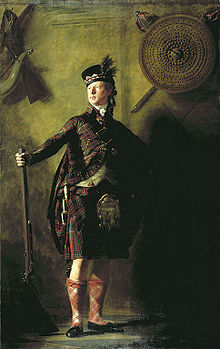 Portrait by Henry Raeburn of Alexander Ranaldson MacDonell of Glengarry in 1812. MacDonnell claimed to support Highland Culture, while simultaneously clearing his tenants.
Portrait by Henry Raeburn of Alexander Ranaldson MacDonell of Glengarry in 1812. MacDonnell claimed to support Highland Culture, while simultaneously clearing his tenants.
In 1807 Elizabeth Gordon, 19th Countess of Sutherland, touring her inheritance with her husband Lord Stafford (later made Duke of Sutherland), wrote that "he is seized as much as I am with the rage of improvements, and we both turn our attention with the greatest of energy to turnips". As well as turning land over to sheep farming, Stafford planned to invest in creating a coal-pit, salt pans, brick and tile works and herring fisheries. That year his agents began the evictions, and 90 families were forced to leave their crops in the ground and move their cattle, furniture and timbers to the land they were offered 20 miles (32 km) away on the coast, living in the open until they had built themselves new houses. Stafford's first Commissioner, William Young, arrived in 1809, and soon engaged Patrick Sellar as his factor who pressed ahead with the process while acquiring sheep farming estates for himself.[3]
Elsewhere, the flamboyant Alexander Ranaldson MacDonell of Glengarry portrayed himself as the last genuine specimen of the true Highland Chief while his tenants were subjected to a process of relentless eviction.[3]
To landlords, "improvement" and "clearance" did not necessarily mean depopulation. At least until the 1820s, when there were steep falls in the price of kelp, landlords wanted to create pools of cheap or virtually free labour, supplied by families subsisting in new crofting townships. Kelp collection and processing was a very profitable way of using this labour, and landlords petitioned successfully for legislation designed to stop emigration. This took the form of the Passenger Vessels Act 1803. Attitudes changed during the 1820s and, for many landlords, the potato famine which began in 1846 became another reason for encouraging or forcing emigration and depopulation.
Potato famine
Main article: Highland Potato Famine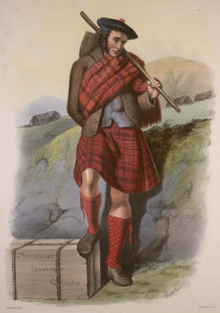 A romanticised early Victorian depiction of a member of Clan MacAlister leaving Scotland for Canada, by R. R. McIan.
A romanticised early Victorian depiction of a member of Clan MacAlister leaving Scotland for Canada, by R. R. McIan.
As in Ireland, the potato crop failed in the mid nineteenth century, and a widespread outbreak of cholera further weakened the Highland population. The ongoing clearance policy resulted in starvation, deaths, and a secondary clearance, when families either migrated voluntarily or were forcibly evicted. There were many deaths of children and old people. As there were few alternatives, people emigrated, joined the British army, or moved to growing urban centres such as Glasgow, Edinburgh, and Dundee in Lowland Scotland and Newcastle-upon-Tyne and Liverpool in the north of England. In places some people were given economic incentives to move, but few historians dispute that in many instances landlords used violent methods.
Account by Donald McLeod
Donald McLeod, a Sutherland crofter, later wrote about the events he witnessed:
The consternation and confusion were extreme. Little or no time was given for the removal of persons or property; the people striving to remove the sick and the helpless before the fire should reach them; next, struggling to save the most valuable of their effects. The cries of the women and children, the roaring of the affrighted cattle, hunted at the same time by the yelling dogs of the shepherds amid the smoke and fire, altogether presented a scene that completely baffles description — it required to be seen to be believed.
A dense cloud of smoke enveloped the whole country by day, and even extended far out to sea. At night an awfully grand but terrific scene presented itself — all the houses in an extensive district in flames at once. I myself ascended a height about eleven o'clock in the evening, and counted two hundred and fifty blazing houses, many of the owners of which I personally knew, but whose present condition — whether in or out of the flames — I could not tell. The conflagration lasted six days, till the whole of the dwellings were reduced to ashes or smoking ruins. During one of these days a boat actually lost her way in the dense smoke as she approached the shore, but at night was enabled to reach a landing-place by the lurid light of the flames.[4]
Accounts like those of McLeod and General David Stewart of Garth brought widespread condemnation and The Highland Land League eventually achieved land reform in the enactment of Crofting Acts, but these could not bring economic viability and came too late at a time when the land was already suffering from depopulation.
Second phase of the Clearances
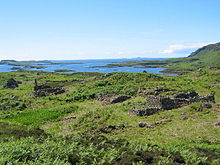 Ormaig was once the principal settlement on the Isle of Ulva near Mull. It had been inhabited since prehistoric times, until it was cleared by Francis William Clark in the mid 19th century.
Ormaig was once the principal settlement on the Isle of Ulva near Mull. It had been inhabited since prehistoric times, until it was cleared by Francis William Clark in the mid 19th century.
It was only in the mid-nineteenth century that the second, more brutal phase of the Clearances began; this was well after the 1822 visit by George IV, when lowlanders set aside their previous distrust and hatred of the Highlanders and identified with them as national symbols. However, the cumulative effect was particularly devastating to the cultural landscape of Scotland in a way that did not happen in other areas of Britain.
Elizabeth Leveson-Gower, Duchess of Sutherland, and her husband George Leveson-Gower, 1st Duke of Sutherland, conducted brutal clearances between 1811 and 1820.[5][6] Evictions at the rate of 2,000 families in one day were not uncommon. Many starved and froze to death where their homes had once been. The Duchess of Sutherland, on seeing the starving tenants on her husband's estate, remarked in a letter to a friend in England, "Scotch people are of happier constitution and do not fatten like the larger breed of animals."[7]
While the collapse of the clan system can be attributed more to economic factors and the repression that followed the Battle of Culloden, the widespread evictions resulting from the Clearances severely affected the viability of the Highland population and culture. To this day, the population in the Scottish Highlands is sparse and the culture is diluted, and there are many more sheep than people. Although the 1901 census did return 230,806 Gaelic speakers in Scotland, today this number has fallen to below 60,000. Counties of Scotland in which over 50% of the population spoke Gaelic as their native language in 1901, included Sutherland (71.75%), Ross and Cromarty (71.76%), Inverness (64.85%) and Argyll (54.35%). Small percentages[quantify] of Gaelic speakers were recorded in counties such as Nairn, Bute, Perth and Caithness.
What the Clearances started, however, the First World War almost completed. A huge percentage of Scots were among the vast numbers killed, (Scotland lost over 147,000 men in World War One - 20% of Britain's losses while only being 10% of the total British population) and this greatly affected the remaining population of Gaelic speakers in Scotland.
The 1921 census, the first conducted after the end of the war, showed a significant decrease in the proportion of the population that spoke Gaelic. The percentage of Gaelic speakers in Argyll had fallen to well below 50% (34.56%), and the other counties mentioned above had experienced similar decreases. Sutherland's Gaelic-speaking population was now barely above 50%, while Inverness and Ross and Cromarty had fallen to 50.91% and 60.20%, respectively.
However, the Clearances did result in significant emigration of Highlanders to North America and Australasia — where today are found considerably more descendants of Highlanders than in Scotland itself.
One estimate for Cape Breton, Nova Scotia has 25,000 Gaelic-speaking Scots arriving as immigrants between 1775 and 1850. At the beginning of the twentieth century, there were an estimated 100,000 Gaelic speakers in Cape Breton, but because of economic migration to English-speaking areas and the lack of Gaelic education in the Nova Scotian school system, the numbers of Gaelic speakers fell dramatically. By the beginning of the 21st century, the number of native Gaelic speakers had fallen to well below 1,000.[8]
Memorials to the Clearances
The highland clearances are still remembered especially in the areas affected by the forced emigration and hardship endured by the peoples of the Highlands and their descendants across the world.[citation needed]
Scotland
On 23 July 2007, the Scottish First Minister Alex Salmond unveiled a 10 ft-high bronze "Exiles" statue in Helmsdale, Sutherland, which commemorates the people who were cleared from the area by landowners and left their homeland to begin new lives overseas. The statue, which depicts a family leaving their home, stands at the mouth of the Strath of Kildonan and was funded by Dennis Macleod, a Scottish-Canadian mining millionaire who also attended the ceremony.[9]
Canada
An identical 10 ft-high bronze "Exiles" statue has also been set up on the banks of the Red River—the modern city of Winnipeg was founded by those who left Scotland for Canada.[10]
See also
- Scottish clan
- Lowland Clearances
- Clan MacDonnell of Glengarry
- Highland Land League
- Crofting
- Enclosure
- Scottish Canadian
References
- ^ Houston, Robert, Allan Whyte, Ian D., Scottish Society, 1500-1800, Cambridge University Press, 2005, ISBN 0521891671, 9780521891677, pg 148-151
- ^ Campbell, James (1984). Invisible Country: A Journey through Scotland. Weidenfeld and Nicolson. p. 81. ISBN 0297783718.
- ^ a b The Highland Clearances, John Prebble, Penguin Books, 1963, ISBN 0-14-002837-4
- ^ "Highland Clearances by Janet Mackay". http://www.electricscotland.com/history/hclearances.htm.
- ^ "George Granville Leveson-Gower (1st Duke of Sutherland)". Gazetteer for Scotland. http://www.scottish-places.info/people/famousfirst621.html. Retrieved 2008-02-01.
- ^ Noble, Ross "The Cultural Impact of the Highland Clearances" BBC History. Retrieved 7 July 2008.
- ^ The Highland Clearances - An Introduction
- ^ "Hector MacNeil, Gaelic Director, the Gaelic College, St. Ann's, Nova Scotia". http://www.celtic-colours.com/culture.html.[dead link]
- ^ "Memorial statue marks clearances " BBC. Retrieved 5 October 2008.
- ^ "Worldwide plan for Clearances memorials". The Scotsman. 2007-07-07. http://heritage.scotsman.com/topics.cfm?tid=1272&id=1059252007. Retrieved 2008-10-05.
External links
- Narratives in a Landscape: Monuments and Memories of the Sutherland Clearances dissertation on the landscape of the Clearances
- Highland Clearances by Janet Mackay
- Highlanderweb - Highland clearances[dead link]
- The Tragic Highland Clearances, a history
- Abandoned communities - the clearance of Strathnaver 1814-1819
- The Highland Clearances - An Introduction
- The Cultural Impact of the Highland Clearances, a BBC History article by Ross Noble
- The Highland Clearances[dead link]. Article by Thomas Devine, published in Refresh 4, Spring 1987.
- The impact of the Highland Clearances on one Mull family and their aftermath - a linear case study. http://www.blackshouse.demon.co.uk/knockan.htm
- Badbea Descendants Website
Further reading (with bibliography)
- An overview of the Clearances, Alexander McKenzie, 1881.
- Gloomy Memories, Donald Macleod, 1857 (first-hand account of Sutherland clearances).
- "Soil and Soul: People versus Corporate Power", Alastair McIntosh, Aurum Press Ltd, 2004, ISBN 1854108026
- The Highland Clearances, John Prebble, Secker & Warburg, 1963
- The Highland Clearances, Eric Richards, Birlinn Books, 2000.
- A history of the Highland clearances. Vol.1, Agrarian transformation and the evictions 1746-1886", Eric Richards, Croom Helm, c1982, 085664496X
- The Strathnaver Trilogy, Ian Grimble. 3vols: Chief of MacKay, The Trial of Patrick Sellar, and The World of Rob Donn.
- The People of Glengarry. Highlanders in Transition, 1745-1820, Marianne McLean, McGill-Queen's University Press; 1993.
- Die Schottischen Clans im 18. Jahrhundert, Vom Wandel und Ende einer Hochlandgesellschaft am Rande Europas, A Personal Passion Play in Scottish History and Bibliography, Hubert Gebele, Regensburg 2003.
- The Making of the Crofting Community, James Hunter, John Donald Publishers Ltd; 2nd Revised edition edition (27 Jun 2000).
- Das Kapital, Karl Marx, Charles H. Kerr & Company; 1906, Volume I, Part VIII, Chapter XXVI.
- Wealth of Nations, Adam Smith, The Modern Library Classics, Complete and Unabridged, 2000, Book III, Chapter IV
Scottish clans Clans with chiefs Agnew · Anstruther · Arbuthnott · Arthur · Bannerman · Barclay · Borthwick · Boyd · Boyle · Brodie · Broun · Bruce · Buchan · Burnett · Cameron · Campbell · Carmichael · Carnegie · Cathcart · Charteris · Chattan · Chisholm · Cochrane · Colquhoun · Colville · Cranstoun · Crichton · Cumming · Darroch · Davidson · Dewar · Drummond · Dunbar · Dundas · Durie · Elliot · Elphinstone · Erskine · Farquharson · Fergusson · Forbes · Forsyth · Fraser · Fraser of Lovat · Gayre · Gordon · Graham · Grant · Gregor · Grierson · Guthrie · Haig · Haldane · Hamilton · Hannay · Hay · Henderson · Home · Hope · Hunter · Irvine · Jardine · Johnstone · Keith · Kennedy · Kerr · Kincaid · Lamont · Leask · Lennox · Leslie · Lindsay · Lockhart · Lumsden · Lyon · MacAlister · MacBain · MacDonald · Macdonald of Clanranald · MacDonald of Keppoch · Macdonald of Sleat · MacDonell of Glengarry · MacDougall · Macdowall · MacIntyre · Mackay · Mackenzie · Mackinnon · Mackintosh · Maclachlan · Maclaine of Lochbuie · MacLaren · MacLea (Livingstone) · Maclean · MacLennan · MacLeod · MacLeod of Lewis · MacMillan · Macnab · Macnaghten · MacNeacail · MacNeil · Macpherson · MacTavish · MacThomas · Maitland · Makgill · Malcolm (MacCallum) · Mar · Marjoribanks · Matheson · Menzies · Moffat · Moncreiffe · Montgomery · Morrison · Munro · Murray · Napier · Nesbitt · Nicolson · Ogilvy · Oliphant · Primrose · Ramsay · Rattray · Riddell · Robertson · Rollo · Rose · Ross · Ruthven · Sandilands · Scott · Scrymgeour · Sempill · Shaw · Sinclair · Skene · Spens · Stirling · Strange · Stuart of Bute · Sutherland · Swinton · Trotter · Urquhart · Wallace · Wedderburn · Wemyss · Wood ·
Armigerous clans Abercromby · Abernethy · Adair · Adam · Aikenhead · Ainslie · Aiton · Allardice · Anderson · Armstrong · Arnott · Auchinleck · Baillie · Baird · Balfour · Bannatyne · Baxter · Bell · Belshes · Bethune · Beveridge · Binning · Bissett · Blackadder · Blackstock · Blair · Blane · Blyth · Boswell · Brisbane · Buchanan · Butter · Byres · Cairns · Calder · Caldwell · Callender · Campbell of Breadalbane · Campbell of Cawdor · Carruthers · Cheyne · Chalmers · Clelland · Clephane · Cockburn · Congilton · Craig · Crawford · Crosbie · Cunningham · Dalmahoy · Dalrymple · Dalzell · Dennistoun · Don · Douglas · Duncan · Dunlop · Edmonstone · Fairlie · Falconer · Fenton · Fleming · Fletcher · Forrester · Fotheringham · Fullarton · Galbraith · Galloway · Gardyne · Gartshore · Ged · Gibsone · Gladstains · Glas · Glen · Glendinning · Gray · Gunn · Haliburton · Halkerston · Halket · Hepburn · Heron · Herries · Hogg · Hopkirk · Horsburgh · Houston · Hutton · Inglis · Innes · Kelly · Kinloch · Kinnaird · Kinnear · Kinninmont · Kirkcaldy · Kirkpatrick · Laing · Lammie · Langlands · Learmonth · Little · Logan · Logie · Lundin · Lyle · MacAulay · Macbrayne · MacDuff · MacEwen · MacFarlane · Macfie · Macgillivray · MacInnes · MacIver · Mackie · MacLellan · Macquarrie · Macqueen · Macrae · Masterton · Maule · Maxton · Maxwell · McCorquodale · McCulloch · McKerrell · Meldrum · Melville · Mercer · Middleton · Moncur · Monteith · Monypenny · Mouat · Moubray · Mow · Muir · Murray of Atholl · Nairn · Nevoy · Newlands · Newton · Norvel · Ochterlony · Orrock · Paisley · Paterson · Pennycook · Pentland · Peter · Pitblado · Pitcairn · Pollock · Polwarth · Porterfield · Preston · Pringle · Purves · Rait · Ralston · Renton · Roberton · Rossie · Russell · Rutherford · Schaw · Seton · Skirving · Somerville · Spalding · Spottiswood · Stewart · Stewart of Appin · Strachan · Straiton · Strange · Sydserf · Symmers · Tailyour · Tait · Tennant · Troup · Turnbull · Tweedie · Udny · Vans · Walkinshaw · Wardlaw · Watson · Wauchope · Weir · Whitefoord · Whitelaw · Wishart · Young
Culture and society Scotland · Clan chief · Septs · Clan badge · Clan crest · Clan battles · Tartan · Bagpipes · Clearances · Kilt · Manrent · The Highlands · Battle of Culloden · Highland games · Border Reivers · Scottish heraldry · Scottish surnames
 Scotland topics
Scotland topicsHistory Timeline · Prehistoric · Roman times · Kingdom · High Middle Ages · Davidian Revolution · Wars of Independence · Late Middle Ages · Reformation · Colonisation of the Americas · Acts of Union 1707 · Jacobitism · Enlightenment · Highland Clearances · Lowland Clearances · ModernGeography Geology · Climate · Demographics · Mountains and hills · Islands · Lochs · Waterfalls · Fauna · Flora · Highlands · Lowlands · Central Belt · Anglo-Scottish borderEconomy Companies · Bank of Scotland · Royal Bank of Scotland · North Sea oil · Whisky · Tourism · Harris Tweed · Renewable energy · Transport · Saltire FoundationLaw People Politics Religion Languages Culture Clans · Cuisine · Education · Flags · Coat of arms · Anthem · Hogmanay · Innovations · Literature · Music · Sport · World Heritage Sites · National identity · National symbols · Scottish surnames Category ·
Category ·  Portal ·
Portal ·  WikiProjectCategories:
WikiProjectCategories:- History of the Scottish Highlands
- Highlands and Islands of Scotland
- Forced migration
- Scottish emigration
- Scottish diaspora
- 18th century in Scotland
- 19th century in Scotland
- Highland Clearances
- Enclosures
Wikimedia Foundation. 2010.

